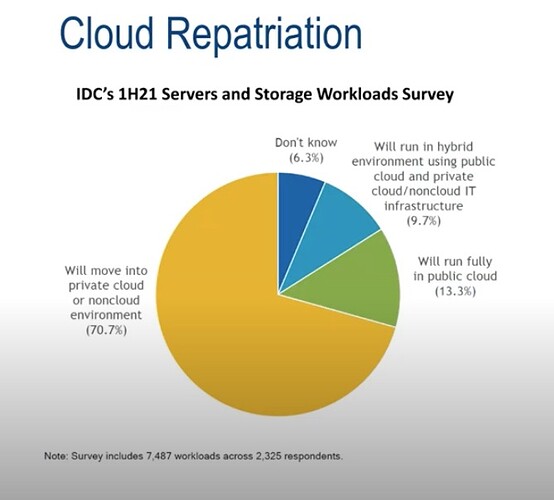Color me not surprised.
Can you (or others) explain to me the reason people are moving off the public clouds and back to private clouds? Price, security, control, etc?
And what exactly is a ‘Private Cloud’? Are companies re-creating computer rooms, or is this Private Virtual Machines on public hosting providers? So, is Xojo Cloud a Private Cloud?
The repatriation term I hear most often among our industry partners is On-Prem and/or Edge. I’m told there are many reasons companies are moving back from the cloud among them are of course price, security, and control. One of the additional points and one I’ve tried to make on this forum recently is that business users have grown tired of these website-like applications that are running in the cloud. Speed and efficiency for workers in the business environment has always been based on fast keyboard usage (not webpages and a mouse). I hear it all the time, the UX of such applications are for average consumers and not trained business users. When describing the lack of efficiency for some users in his department one department leader said, “You can’t fly like an eagle when you’re tied to the rodent”. This is one reason I am so disappointed in Xojo’s move to Web 2.0. At a time when business is moving away from website-like cloud applications to on-prem keyboard-efficient applications. Xojo is “bringing up the rear” by forcing us into website-like applications and ending a tried-and-true product that’s a perfect fit for what’s about to come.
Like I said before. Oh well.
Xojo Cloud is a public cloud.
Yeah that’s probably why the terms on-prem (and edge) have become the vernacular of choice. It’s a lot less confusing.
Back to IBM 3270 terminals and a bunch of keyboard jocks, then, I suppose. I’ve not seen a real one of those since checking into the Emergency Room at the main hospital in Atlanta in Feb 1982.
Our customers want to see efficient but “modern looking” web apps. Not everyone requires a lot of data entry. In our case most of our client facing apps are reports where the customer selects a couple of dates, enters a tracking number or stuff like that.
I started my tech career back then and surprisingly a good terminal operator on a 3270 could run rings around a webpage and mouse user today. Once they learned “the keystrokes” a user could go anywhere in the system and do everything quickly. It’s a lot faster for an experienced user to hit Tab four times than to remove their hand from the keyboard to move the mouse cursor down. Just saying
We have some such apps in Clipper. We are working on migrating them to web apps.
If you’re doing repetetive stuff I imagine that’s true. As a developer, I almost never do.
I’m not saying there isn’t a place for the mouse. I’m just saying there’s also a requirement for fast keyboard usage too. In my other life I was a film editor and the fastest editors I ever worked with never took their hands off the keyboard at all.
BTW I started my career developing DOS applications and difficult as it was back then I always made sure my UI was attractive and “modern looking”. I had a character driven DOS screen that looked like Windows (actually more like Gnome) even before there was a Windows.
I loved Clipper. Way ahead of it’s time in so many ways.
BTW does anyone remember the use of TSR’s (terminate and stay resident programs) in DOS. One keystroke combination and “boom” you’re someplace else. I do that kind of thing a lot in Web 1.0 using containers. It’s much faster than additional page loads and the like.
No. I never hasd the misfortune to need to do anything on a DOS machine. Equally, I was able to avoid all the joke versions of Windows until 98 came along.
I hear you! The first Windows version I truly embraced was NT. In my DOS days I used to run Windows 3.x as a task under Quarterdeck DESQview. Users were amazed that they could run Lotus 123, WordPerfect, and Windows 3.0 simultaneously and switch seamlessly between the three. Other VAR’s tried to run Lotus and WordPerfect as DOS tasks under Windows which was usually a total disaster since any Windows error (which happened often) would tend to crash all the client apps too. Needless to say my method which was always very stable tended to make me extremely popular in large MIS departments.
Several memories. I wrote lots of TSR’s using my “Peter Norton Programmer’s Guide to the IBM PC” as reference guide to the BIOS and DOS “API” (System calls).
Clipper apps too.
And before Windows NT existing, NetWare was the DOS compatible OS that dominated the networked file systems and print servers.
I bet you had a love/hate relationship with MASM as I did, too. Lol
Kids of today have no idea what we went through to make things work. ![]()
I had only love for TASM. ![]()
